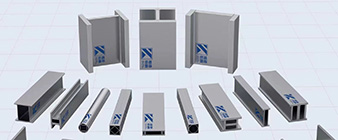This data sheet applies to stainless steel 904L / 1.4539 hot and cold rolled sheet and strip, semi-finished products, bars, rolled wire and profiles as well as seamless and welded tubes for pressure purposes.
- Chemical plant, oil refinery, petrochemical plants
- bleaching tanks for the paper industry, combustion gas desulfurisation plants
- application in sea water, sulphuric and phosphoric acid. Due to the low C-content, the resistance to intergranular corrosion is also guaranteed in the welded condition.
| Element | % Present (in product form) |
|---|---|
| Carbon (C) | 0.02 |
| Silicon (Si) | 0.70 |
| Manganese (Mn) | 2.00 |
| Phosphorous (P) | 0.03 |
| Sulfur (S) | 0.01 |
| Chromium (Cr) | 19.00 – 21.00 |
| Nickel (Ni) | 24.00 – 26.00 |
| Nitrogen (N) | 0.15 |
| Molybdenum (Mo) | 4.00 – 5.00 |
| Copper (Cu) | 1.20 – 2.00 |
| Iron (Fe) | Balance |
| Product Form | ||||||||
|---|---|---|---|---|---|---|---|---|
| C | H | P | L | L | TW/TS | |||
| Thickness (mm) Max. | 8.0 | 13.5 | 75 | 160 | 2502) | 60 | ||
| Yield Strength | Rp0.2 N/mm2 | 2403) | 2203) | 2203) | 2304) | 2305) | 2306) | |
| Rp1.0 N/mm2 | 2703) | 2603) | 2603) | 2603) | 2603) | 2503) | ||
| Tensile Strength | Rm N/mm2 | 530 – 7303) | 530 – 7303) | 520 – 7203) | 530 – 7304) | 530 – 7305) | 520 – 7206) | |
| Elongation min. in % | Jmin (Longitudinal) | – | 100 | 100 | 100 | – | 120 | |
| Jmin (Transverse) | – | 60 | 60 | – | 60 | 90 | ||
| Density at 20°C kg/m3 | 8.0 | |
|---|---|---|
| Thermal Conductivity W/m K at | 20°C | 12 |
| Modulus of Elasticity kN/mm2 at | 20°C | 195 |
| 200°C | 182 | |
| 400°C | 166 | |
| 500°C | 158 | |
| Specific Thermal Capacity at 20°C J/kg K | 450 | |
| Electrical Resistivity at 20°C Ω mm2/m | 1.0 | |
Standard welding processes for this steel grade are:
- TIG-Welding
- MAG-Welding Solid Wire
- Arc Welding (E)
- Laser Bean Welding
- Laser Bean Welding
When selecting filler metals, consideration must be given to corrosion stress. Due to the cast structure of the welded metal, it may be necessary to use higher-alloy filler metals. Preheating is typically unnecessary for this type of steel. Generally, post-weld heat treatment is not required. Austenitic stainless steels have only 30% of the thermal conductivity of non-alloyed steels. Their melting point is lower than that of non-alloyed steels, therefore austenitic stainless steels require lower heat input for welding.
To avoid overheating or penetration of thinner plates, a higher welding speed must be adopted. Copper backing plates, used for faster heat dissipation, are effective. However, surface fusion welding of copper backing plates is not allowed to prevent cracking in the welded metal. This steel has a much higher coefficient of thermal expansion than non-alloyed steel. Combined with poorer thermal conductivity, this leads to greater deformation. When welding 1.4539, all procedures that reduce deformation (such as reverse sequence welding, alternating welding on both sides of relatively large components during double-V butt welding, and assigning two welders) must be particularly observed.
For product thicknesses exceeding 12mm, double-V butt joints should be prioritized over single-V butt joints. When using MIG welding, the included angle should be 60°-70°; approximately 50° is sufficient. Accumulation of weld seams should be avoided as much as possible.
To prevent severe deformation, shrinkage, or spalling, tack welding must be done at relatively shorter distances (noticeably shorter than those of non-alloyed steel). After welding, tack welds should be ground, or at least, no cracks should appear in the seam. In 1.4539, there is a risk of thermal cracking when welding with austenitic weld metal and excessive heat input.
To mitigate the risk of thermal cracking, it is possible to lower the ferrite content (δ-ferrite) in the weld metal. Ferrite content of up to 10% is beneficial in reducing the risk of thermal cracking and generally does not affect corrosion resistance. It is necessary to weld as thin layers as possible (using stringer bead technique) because higher cooling rates reduce the risk of thermal cracking. During the welding process, rapid cooling should also be ensured to avoid the effects of intergranular corrosion and embrittlement. 1.4539 is highly suitable for laser welding (weldability A according to DVS bulletin 3203, part 3).
If the weld seam width is less than 0.3mm or the product thickness is less than 0.1mm, filler metal is not required. For larger weld seams, similar filler metal can be used. By avoiding oxygen on the surface of the weld seam.
-
 2024-9-24 310S stainless steel structural Beams and columns
2024-9-24 310S stainless steel structural Beams and columns -
 2024-9-20 2205 duplex stainless steel in water treatment industry applications
2024-9-20 2205 duplex stainless steel in water treatment industry applications -
 2024-9-16 2507 super duplex stainless steel
2024-9-16 2507 super duplex stainless steel -
 2024-9-25 1.4307 stainless steel structural profiles advantages
2024-9-25 1.4307 stainless steel structural profiles advantages -
 2024-9-20 Application of Ti Gr 2 / 3.7035 structural profiles in marine industry
2024-9-20 Application of Ti Gr 2 / 3.7035 structural profiles in marine industry -
 2024-9-27 400 / 2.4360 stainless steel structural profiles advantages and applications
2024-9-27 400 / 2.4360 stainless steel structural profiles advantages and applications -
 2024-9-20 Application of Ti Gr 2 / 3.7035 Structural Hollow Stations
2024-9-20 Application of Ti Gr 2 / 3.7035 Structural Hollow Stations



